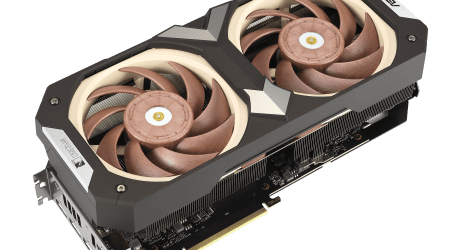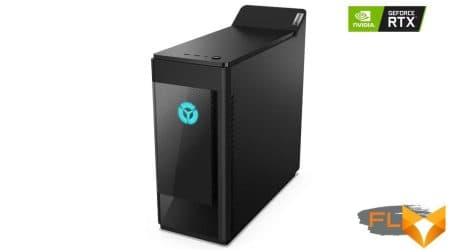


Processors of the Core i5 family are highly respected by gamers. They are noticeably cheaper than representatives of the Core i7 and Core i9 series, but at the same time they provide decent gaming performance, quite sufficient for mid-range gaming builds. And with the advent of Alder Lake processors, this will certainly not change – the 12th generation Core i5 still look like excellent options with an attractive price-performance ratio.
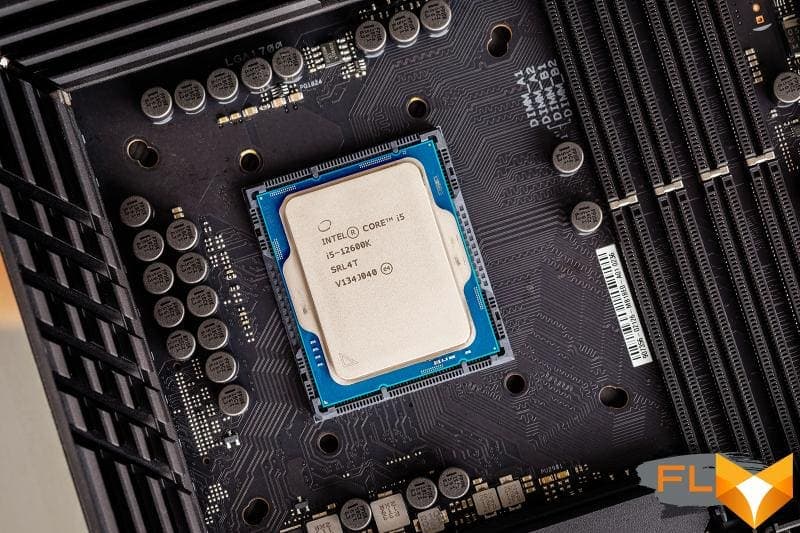
As a result, the Core i5-12600K looks like a very special processor that can be opposed in the lineups of past generations not so much to the Core i5 and Ryzen 5, but to the more powerful chips of the Core i7, Ryzen 7 and even Core i9 series. This is what the Core i5-12600K deserves a personal review in which we compare it with the maximum possible number of competitors from different price segments. Determining the place of this unique Alder Lake chip in the hierarchy of modern CPUs is by no means such an easy task as it might seem at first glance. And the point here is not only the number of cores in itself, but also the fact that the Core i5-12600K is the initial model among all 12th generation Core processors, which has all the innovative features of Alder Lake: a hybrid design and two types of cores – productive and energy efficient.
Previously, we have already talked in detail about the fundamental innovations in the architecture of Alder Lake, and for diving into the details, we recommend that you familiarize yourself with other materials:
- Explain why Intel Alder Lake is this fall’s top processor.
- Review of the Core i9-12900K processor: a revolution in the mind.
- Core i7-12700K review showing that E-cores hurt P-cores, but it’s worse without them.
In the same material, we will primarily focus on the practical aspects of the Core i5-12600K, without serious delving into theory. Nevertheless, we assume that the reader is aware that this processor is endowed with Thread Director technology and therefore it is better to use it in the new Windows 11 operating system. In the old Windows 10, it will run slower than it could (more on this can be read here), so with an eye to the old version of the OS, we would advise you to stop at cheaper versions of the 12th generation Core i5, in which Thread Director and hybridity are not provided.
⇡#Core i5-12600K close-up
The core formula of the Core i5-12600K looks like 6P + 4E, which means that this processor is assembled on the basis of six productive and four energy-efficient cores. The first type of cores (P-cores) has a Golden Cove microarchitecture and is focused on processing foreground threads, the second type (E-cores) is endowed with a Gracemont microarchitecture optimized for background tasks. Thus, in terms of the number of cores, the Core i5-12600K is only slightly inferior to the representatives of the Core i7 series, which have eight performance and four power-efficient cores. But something else is much more interesting – the Core i5-12600K has ten cores capable of performing 16 threads. And this means that technically this processor can be perceived as a candidate to replace the flagships of the previous generation – the Core i7-11900K and even the Core i9-11900K, especially since the Golden Cove cores outperform Cypress Cove by quite tangible 20%.
The Core i5-12600K is not inferior to the flagship Rocket Lake in terms of cache memory. The total volume of all its L2 caches is 9.5 MB (against 4 MB for the Core i9-11900K), and the capacity of the L3 cache is 20 MB (against 16 MB for the Core i9-11900K).
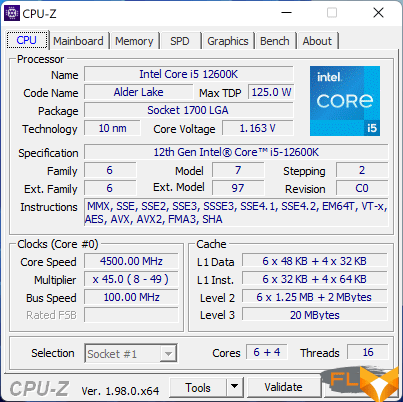
The Core i5-12600K looks worse except for the clock speeds. For its P-cores, the range is 3.7-4.9 GHz, and for E-cores – 2.8-3.6 GHz. At the same time, with a full multi-threaded load with consumption limits removed, the P-cores of this processor keep a frequency of 4.5 GHz, and the E-cores – 3.6 GHz.
The fact that the Core i5-12600K belongs to the new LGA1700 platform definitely plays in favor of the Core i5-12600K. Thanks to it, this processor can be used with high-speed DDR5 SDRAM memory and (so far hypothetically) video cards with PCIe 5.0 interface, which can become significant advantages in the future.
To sum it all up, the Core i5-12600K should be placed in a heavier weight category than one might think from its name alone. This processor is a competitor to at least Core i7 and Ryzen 7, but not to Core i5 and Ryzen 5, which directly follows from its characteristics.
| Core i5-12600K | Ryzen 7 5800X | Core i7-11700K | Ryzen 5 5600X | Core i5-11600K | |
|---|---|---|---|---|---|
| Microarchitecture | Golden Cove + Gracemont | Zen 3 | Cypress Cove | Zen 3 | Cypress Cove |
| Workflow | Intel 7 | TSMC N7 | 14 nm | TSMC N7 | 14 nm |
| Kernels | 10 (6P+4E) | 8 | 8 | 6 | 6 |
| Streams | 16 | 16 | 16 | 12 | 12 |
| P-core frequencies, GHz | 3.7-4.9 | 3.8-4.7 | 3.6-5.0 | 3.7-4.6 | 3.9-4.9 |
| E-core frequencies, GHz | 2.8-3.6 | – | – | – | – |
| TDP/PBP, W | 125 | 105 | 125 | 65 | 125 |
| MTP, W | 150 | 142 | 251 | 88 | 154 |
| L3 cache, MB | 20 | 32 | 16 | 32 | 12 |
| Memory | DDR4-3200 DDR5-4800 | DDR4-3200 | DDR4-3200 | DDR4-3200 | DDR4-3200 |
| Integrated Graphics | UHD 770 | No | UHD 750 | No | UHD 750 |
| PCIe | 16 lines 5.0 4 lines 4.0 | 24 lines 4.0 | 20 lines 4.0 | 24 lines 4.0 | 20 lines 4.0 |
| Price | $289 | $449 | $399 | $299 | $262 |
But the most surprising thing about this novelty is that the increase in the number of cores plus the transition to a new microarchitecture and a new technical process resulted in only a 10% increase in the official price compared to the Core i5-11600K. As a result, the recommended cost of the Core i5-12600K was even slightly lower than that of the obviously weaker six-core Ryzen 5 5600X. The same proportion can be seen in European and American retail, and the version with the disabled Core i5-12600KF graphics core will save an additional $25.
Where exactly the Core i5-12600K is located in the existing Alder Lake lineup and what makes it unique can be clearly seen from the table below.
| Number of cores | Number of threads | Frequency P-cores, GHz | Frequency E-cores, GHz | L3 cache, MB | Graphics | Basic TDP, W | Turbo TDP, W | Price | |
|---|---|---|---|---|---|---|---|---|---|
| i9-12900K | 8P + 8E | 24 | 3.2-5.2 | 2.4-3.9 | 30 | UHD 770 | 125 | 241 | $589 |
| I9-12900 | 8P + 8E | 24 | 2.4-5.1 | 1.8-3.8 | 30 | UHD 770 | 65 | 202 | $489 |
| i7-12700K | 8P + 4E | 20 | 3.6-5.0 | 2.7-3.8 | 25 | UHD 770 | 125 | 190 | $409 |
| i7-12700 | 8P + 4E | 20 | 2.1-4.9 | 1.6-3.6 | 25 | UHD 770 | 65 | 180 | $339 |
| i5-12600K | 6P + 4E | 16 | 3.7-4.9 | 2.8-3.6 | 20 | UHD 770 | 125 | 150 | $289 |
| i5-12600 | 6P | 12 | 3.3-4.8 | – | 18 | UHD 770 | 65 | 117 | $223 |
| i5-12500 | 6P | 12 | 3.0-4.6 | – | 18 | UHD 770 | 65 | 117 | $202 |
| i5-12400 | 6P | 12 | 2.5-4.4 | – | 18 | UHD 730 | 65 | 117 | $192 |
| i3-12300 | 4P | 8 | 3.5-4.4 | – | 12 | UHD 730 | 60 | 89 | $143 |
| i3-12100 | 4P | 8 | 3.3-4.3 | – | 12 | UHD 730 | 60 | 89 | $122 |
The Core i5-12600K is not only the only 10-core processor in the Alder Lake family and the youngest unlocked overclocker CPU, but also the most affordable model using a hybrid architecture and Thread Director technology. In other words, the Core i5-12600K is the only sub-$300 processor that allows Intel’s new approach to CPU design to be tested in action at this stage.
Separately, it should be noted that, unlike the Core i9-12900K and Core i7-12700K, the ten-core Core i5-12600K has rather moderate thermal characteristics. Its maximum heat dissipation (MTP) is set at 150 W, and this is far from a record value by modern standards. For example, the eight-core Ryzen 7 5800X limits power consumption to close to 142W.
The fact that the Core i5-12600K is a processor that does not differ in energy gluttony can be clearly seen in practice. In the graph below, we have combined the consumption of different 16-threaded CPUs under the load formed by the different number of threads in rendering in Cinebench R23 (all artificial limits on the maximum consumption of the CPU in these measurements have been removed). And from this graph it follows that the Core i5-12600K is the most economical option among processors with similar capabilities.
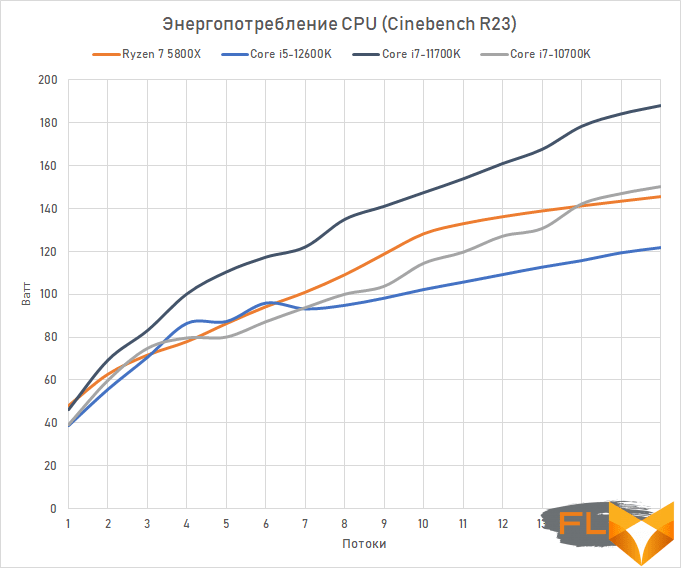
It turns out that the Intel 7 process, which is used in Alder Lake, allows you to produce quite economical processors. And if you do not twist their clock frequencies to the maximum, as is done in the flagship Core i9, then it is difficult to make any claims about their practical consumption. Moreover, the Core i5-12600K turns out to be less voracious not only in comparison with the old Core i7-10700K, but even with the Ryzen 7 5800X. With a maximum 16-thread load, it not only fits into the 150 W thermal package allotted to it with a large margin, but also consumes about 20-25 W less power than an AMD processor requires for operation. However, under certain loads, the Intel chip is still inferior in terms of efficiency to the AMD competitor: this situation is observed when 4, 5, and 6 threads are used.
It remains to add to the above that the Core i5-12600K, like most other Alder Lake desktops, has a built-in UHD Graphics 770 graphics core, which is an accelerator based on the Xe LP architecture with 32 execution units. This is the same graphics as in older Rocket Lake processors, but with slightly increased frequencies – 1.45 vs. 1.3 GHz. But this, of course, cannot fundamentally affect performance in any way, and therefore one cannot count on the possibility of playing the Core i5-12600K without an external video card. For integrated graphics with a more or less acceptable level of 3D performance, you should turn to AMD – the Vega graphics core of the Ryzen 5 5600G and Ryzen 7 5700G processors is several times faster.
⇡#Learn more about power consumption and temperatures
The practical measurement of the power consumption of the Core i5-12600K under various real-world load scenarios confirms that this processor is the most economical offering in its class. Moreover, the higher this load, the stronger the superiority of Alder Lake both over its predecessors and over competitors from the “red” camp is visible.
For example, when multi-threaded rendering in Blender, which can be considered the maximum power-intensive workload, the ten-core Core i5-12600K consumes only about 117 watts, while the power consumption of the previous generation octa-core, the Core i7-11700K, reaches 200 watts. Moreover, the Alder Lake in question consumes noticeably less than the competing Ryzen 7 5800X processor, which requires about 142 watts to run Blender.
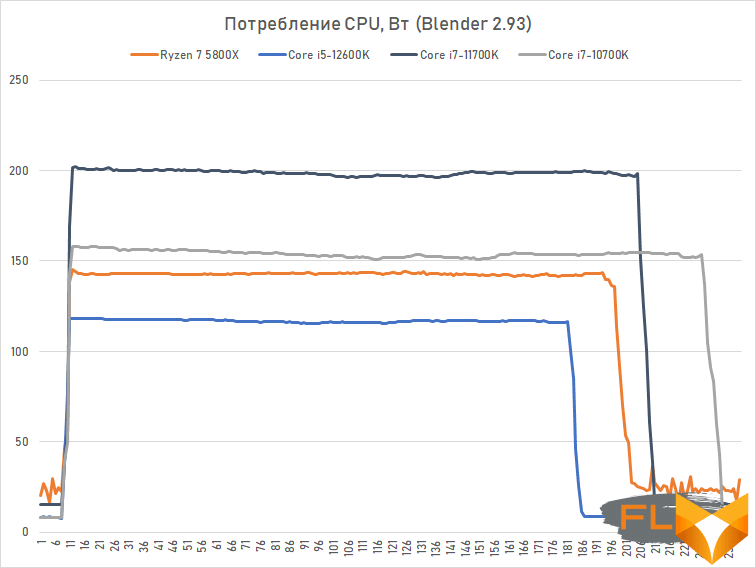
But even more clearly, the energy efficiency of the Core i5-12600K is visible in games that create a rather heterogeneous load and do not load all the available computing resources of the processor at once. We checked the consumption in Horizon Zero Dawn, the new Serious Sam, and Shadow of the Tomb Raider, and in all three cases, the ten-core Core i5-12600K consumed noticeably less than both the Core i7-11700K and the Ryzen 5 5800X. Moreover, the superiority of a representative of the Alder Lake family over a competitor from the AMD camp reached one and a half times!
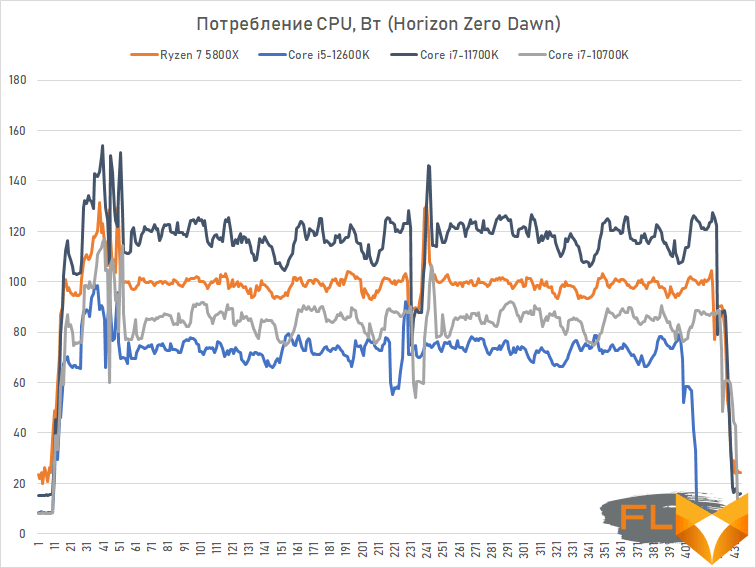

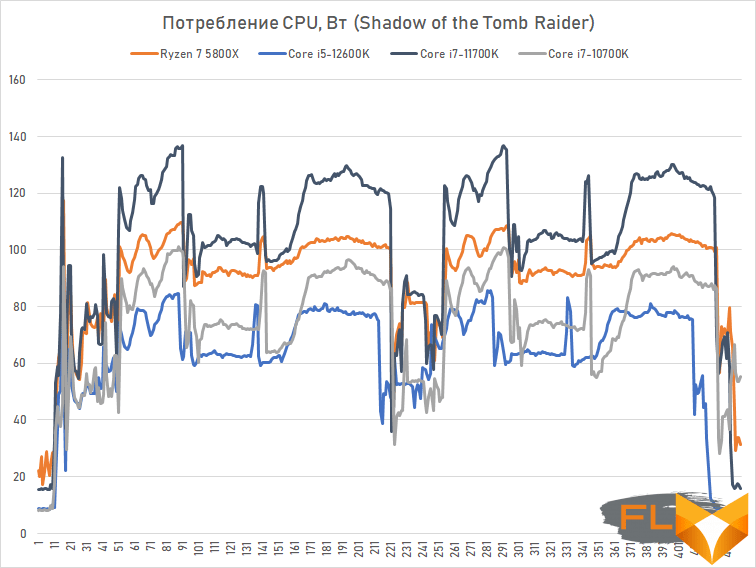
In terms of power consumption, the Core i5-12600K was most similar to the Comet Lake generation, but even compared to this significantly slower Alder Lake processor, it still looks more economical.
But the Core i5-12600K stands out even more clearly on the temperature charts. The fact is that the temperature regime of the CPU is affected not only by its consumption, but also by the ability to effectively remove the generated heat from the processor chip. That is, the quality of the thermal interface used under the processor cover, and the area of the silicon crystal itself (crystals with a larger area are easier to cool), and some other factors like its thickness. This is where the Core i5-12600K has an advantage: this 10-core processor is based on the base 16-core Alder Lake die, which measures 215mm2, slightly larger than Comet Lake’s 206mm< sup>2) and much larger than the Zen 3 CCD die area (81mm2). This makes it quite easy to remove the generated heat from the Core i5-12600K crystal, and when rendering, when power consumption and heat dissipation are maximum, the temperature ratio is as follows.
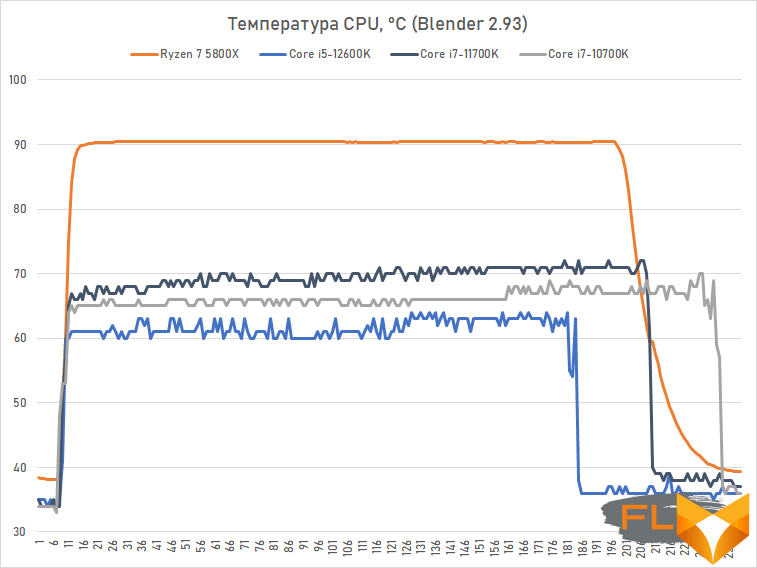
To cool all processors in temperature tests, the same liquid cooling system was used on EKWB components with a 360 mm radiator. But even she could not keep the temperature of the Ryzen 7 5800X within reasonable limits – this processor with a small energy-intensive crystal quickly warmed up to 90 degrees. At the same time, the temperature of the Core i5-12600K did not go beyond 65 degrees. However, other Intel chips did not demonstrate high heating either – even the Core i7-11700K, whose heat dissipation noticeably exceeds that of the Ryzen 7 5800X, reached a maximum temperature of only 72 degrees in Blender. Unfortunately, high operating temperatures are an inherent disadvantage of Ryzen processors, and it manifests itself most acutely in the Ryzen 7 5800X octa-core processors, which use the most unfortunate semiconductor crystals.
Under game load, the situation does not change qualitatively. The temperature of the Core i5-12600K is lower than any other CPU.
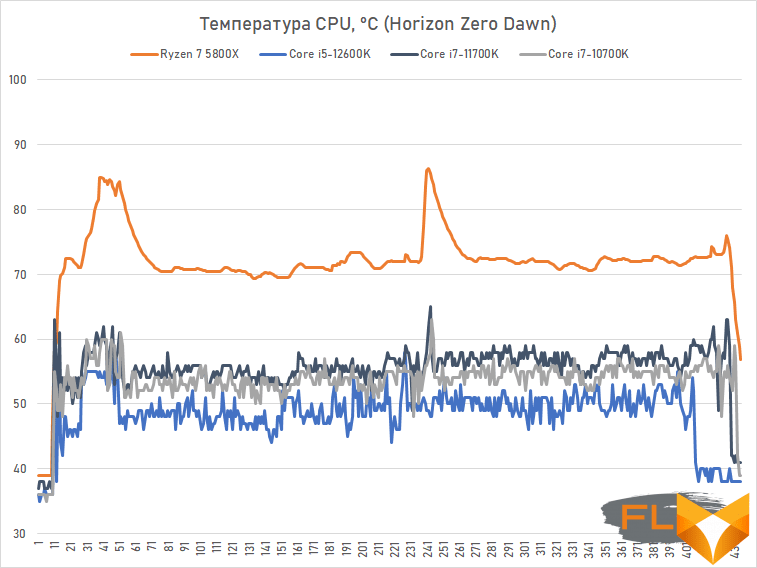
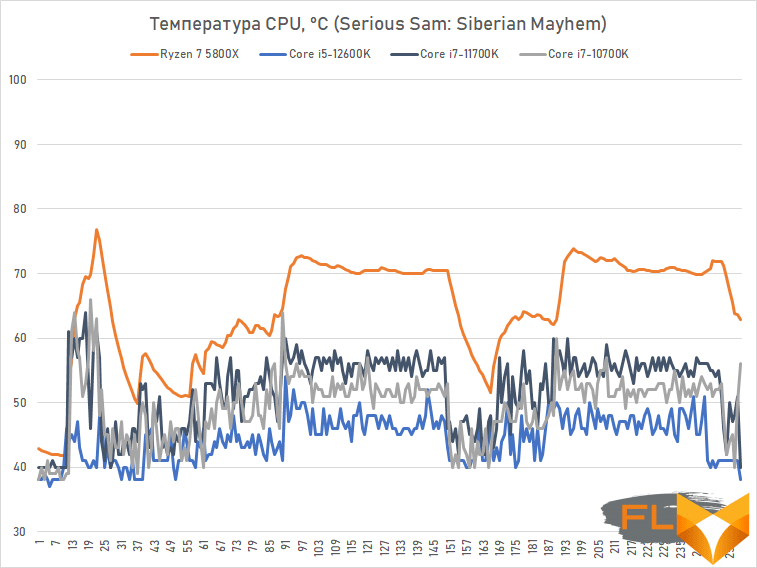
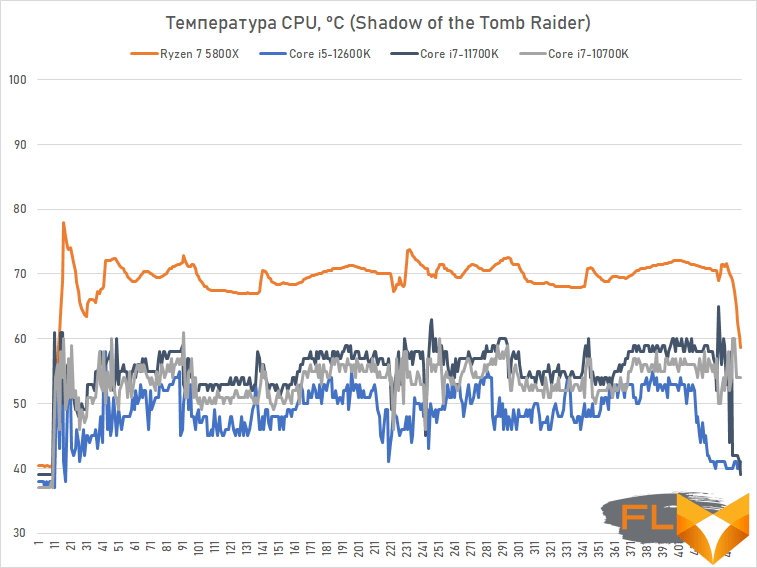
Thus, the Core i5-12600K is not only the most energy efficient, but also the coldest processor among modern 16-thread options. With the advent of Alder Lake, the high heating of mid-range Intel chips is a thing of the past – in the new family, only flagship models can be called voracious.
⇡#Overclocking
Although the Core i5-12600K has moderate heat dissipation, this is not converted into overclocking potential. Perhaps this turned out to be a specific instance of the CPU that fell into our hands, but even the frequency of 5.0 GHz could not submit to it. However, weak overclocking may have a technical explanation. Frequency-compliant chips with high leakage currents for Intel are logical to send first of all to the older Alder Lake models, which should work stably at high clock frequencies. In this case, crystals with low leakage currents obviously fall into simpler CPU models. They don’t scale very well in terms of clock speed, but they are good in terms of energy efficiency, which is exactly what was observed when measuring the power consumption of the Core i5-12600K.
One way or another, the maximum frequency at which our copy of the Core i5-12600K was able to earn was 4.9 GHz (on P-cores). To ensure stability in this case, the voltage on the processor had to be increased in the motherboard BIOS to 1.425 V, and the Load-Line Calibration option set to Level 4 (out of eight available levels). In addition, in order for the processor to work without problems with 256-bit vector registers, an additional adjustment of the multiplier by one was used for the AVX mode, that is, in it the frequency of the overclocked processor was limited to 4.8 GHz. As for the frequency of E-cores, it was not possible to raise it above 3.8 GHz during overclocking.
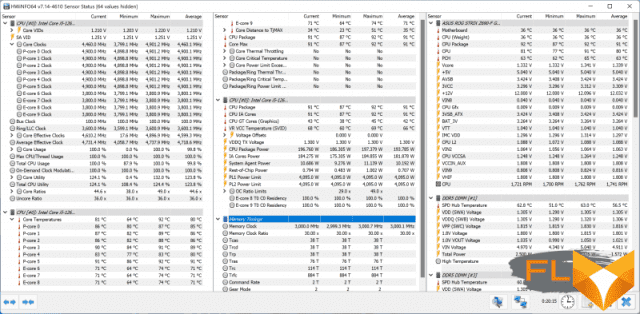
In other words, overclocking the Core i5-12600K is a rather unproductive process. The frequency and performance in this way can be increased only by a few percent, but at the same time, the processor loses energy-efficient properties. Thus, with the described settings, the CPU consumption in the Cinebench R23 multi-threaded test increases almost one and a half times compared to the nominal state – from 122 to 175 watts. This inevitably affects temperatures: for example, when passing stress tests in Prime95 with AVX instructions, where consumption jumps to 204 W, the processor heats up to 98 degrees even if a powerful liquid cooling system is used for heat dissipation. But even if AVX instructions are not enabled in Prime95, the overclocked processor still quickly reaches temperatures over 90 degrees.
⇡#Description of the test system and testing methodology
Since the Core i5-12600K is a processor unique in its positioning, which in terms of price belongs to mid-range solutions, but in terms of characteristics it is able to aim at flagship positions, we had to involve the maximum number of rivals in comparative testing – starting from Core i5 and Ryzen 5 processors past generations and ending with flagship solutions. At the same time, we tested the Core i5-12600K twice – both with the new DDR5 memory and with DDR4 SDRAM, which still allows significant savings when assembling a new system.
- Processors:
- AMD Ryzen 9 5950X (Vermeer, 16 cores + SMT, 3.4-4.9GHz, 64MB L3);
- AMD Ryzen 9 5900X (Vermeer, 12 cores + SMT, 3.7-4.8GHz, 64MB L3);
- AMD Ryzen 9 3950X (Matisse, 16 cores + SMT, 3.5-4.7GHz, 64MB L3);
- AMD Ryzen 9 3900XT (Matisse, 12 cores + SMT, 3.8-4.7GHz, 64MB L3);
- AMD Ryzen 7 5800X (Vermeer, 8 cores + SMT, 3.8-4.7GHz, 32MB L3);
- AMD Ryzen 7 3800XT (Matisse, 8 cores + SMT, 3.8-4.7GHz, 32MB L3);
- AMD Ryzen 5 5600X (Vermeer, 6 cores + SMT, 3.7-4.6GHz, 32MB L3);
- AMD Ryzen 5 3600 (Matisse, 6 cores + SMT, 3.6-4.2GHz, 32MB L3);
- Intel Core i9-12900K (Alder Lake, 8P+8E-cores + HT, 3.5-5.3/2.4-3.9GHz, 30MB L3);
- Intel Core i9-11900K (Rocket Lake, 8 cores + HT, 3.5-5.3GHz, 16MB L3);
- Intel Core i9-10900K (Comet Lake, 10 cores + HT, 3.7-5.3GHz, 20MB L3);
- Intel Core i7-12700K (Alder Lake, 8P+4E-cores + HT, 3.6-5.0/2.7-3.8GHz, 25MB L3);
- Intel Core i7-11700K (Rocket Lake, 8 cores + HT, 3.6-5.0 GHz, 16MB L3);
- Intel Core i7-10700K (Comet Lake, 8 cores + HT, 3.8-5.1GHz, 16MB L3);
- Intel Core i5-12600K (Alder Lake, 6P+4E-cores + HT, 3.7-4.9/2.8-3.6GHz, 20MB L3);
- Intel Core i5-11600K (Rocket Lake, 6 cores + HT, 3.9-4.9 GHz, 12MB L3);
- Intel Core i5-10600K (Comet Lake, 6 cores + HT, 4.1-4.8 GHz, 12MB L3).
- CPU cooler: EKWB custom coolant
- Motherboards:
- ASUS ROG Strix X570-E Gaming WiFi (Socket AM4, AMD X570);
- ASUS ROG Strix Z590-A Gaming WiFi (LGA1200, Intel Z590);
- ASUS ROG Strix Z690-A Gaming WiFi D4 (LGA1700, Intel Z690);
- ASUS ROG Strix Z690-F Gaming WiFi (LGA1700, Intel Z690).
- Memory:
- 2x16GB DDR4-3600 SDRAM, 16-18-18-38 (Crucial Ballistix RGB BL2K16G36C16U4BL);
- 2x16GB DDR5-6000 SDRAM, 38-38-38-76 (G.Skill Trident Z5 RGB F5-6000U4040E16GX2-TZ5RK).
- Video Card: NVIDIA GeForce RTX 3090 Founders Edition (GA102, 1395-1695/19500MHz, 24GB GDDR6X 384-bit).
- Disk subsystem: Intel SSD 760p 2TB (SSDPEKKW020T8X1).
- Power supply: Thermaltake Toughpower DPS G RGB 1000W Titanium (80 Plus Titanium, 1000W).
All compared processors were tested with canceled artificial consumption restrictions. This means that the PPT (for AMD platform) and PL1/PL2 (for AMD platform) limits are ignored, instead the maximum possible frequencies are used in order to obtain maximum performance.
The memory subsystems were configured using XMP profiles. LGA1200 and Socket AM4 processors were tested with DDR4-3600, and Alder Lake with DDR4-3600 and DDR5-6000.
Testing was performed on the Microsoft Windows 11 Pro (21H2) Build 22000.282.0 operating system with KB5005635 and KB5006746 updates installed and using the following driver set:
- AMD Chipset Driver 3.10.08.506;
- Intel Chipset Driver 10.1.18838.8284;
- Intel SerialIO Driver 30.100.2105.7;
- Intel Management Engine Interface 2124.100.0.1096;
- NVIDIA GeForce 511.23 Driver.
Description of the tools used to measure computing performance:
Comprehensive benchmarks:
- Futuremark PCMark 10 Professional Edition 2.1.2508 – testing in Essentials scenarios (typical work of the average user: launching applications, surfing the Internet, video conferencing), Productivity (office work with a word processor and spreadsheets), Digital Content Creation (creating a digital content: photo editing, non-linear video editing, rendering and visualization of 3D models).
- 3DMark Professional Edition 2.22.7336 – testing in the CPU Profile 1.1 scenario with eight active threads and at the maximum possible processor load.
Applications:
- 7-zip 21.02 – archiving speed testing. The time taken by the archiver to compress a directory with various files with a total volume of 3.1 GB is measured. Uses LZMA2 algorithm and maximum compression ratio.
- Adobe Photoshop 2021 22.4.3 – Graphics performance testing. The average execution time of the Puget Systems Adobe Photoshop CC Benchmark 18.10 test script, which simulates the typical processing of an image taken by a digital camera, is measured.
- Adobe Photoshop Lightroom Classic 10.3 – Performance test for batch processing of a series of RAW images. The test scenario includes post-processing and export to JPEG at a resolution of 1920 × 1080 and a maximum quality of two hundred 16-megapixel RAW images taken with a Fujifilm X-T1 digital camera.
- Adobe Premiere Pro 2021 15.4.0 – Performance testing for non-linear video editing. Measures rendering time to YouTube 4K for a project containing HDV 2160p30 footage with various effects applied.
- Blender 2.93.5 – testing the speed of the final rendering in one of the popular free packages for creating three-dimensional graphics. The duration of building the final model pavillon_barcelona_v1.2 from Blender Benchmark is measured.
- Mathworks Matlab R2021b (9.11.0) – testing the speed of engineering and mathematical calculations in a popular mathematical package. A standard benchmark is used, which includes matrix and vector operations, the solution of differential and symmetric sparse linear systems of equations, as well as the construction of 2D and 3D plots.
- Microsoft Visual Studio 2017 (15.9.40) – Compile time measurement for a large MSVC project – Blender 2.79b professional 3D package.
- Stockfish 14.1 – testing the speed of the popular chess engine. The speed of enumeration of options in the position “1q6/1r2k1p1/4pp1p/1P1b1P2/3Q4/7P/4B1P1/2R3K1 w” is measured.
- SVT-AV1 v0.8.6 – testing the speed of video transcoding into the promising AV1 format. Performance is measured using a raw 1080p@50FPS AVC video file with a bitrate of about 30 Mbps.
- Topaz Video Enhance AI v2.3.0 – performance testing in an AI-based program to improve video detail. The test uses the original video at 640×360 resolution, doubled using the Artemis Anti Aliasing v9 model.
- V-Ray 5.00 – Benchmark the performance of a popular rendering system using the standard V-Ray Benchmark Next application.
- x265 3.5+8 10bpp – testing the speed of transcoding video to H.265/HEVC format. To evaluate performance, we use the original 2160p@24FPS AVC video file with a bitrate of about 42 Mbps.
Games:
- Chernobylite. Разрешение 1920 × 1080: Graphics Quality = Ultra.
- Civilization VI: Gathering Storm.Resolution 1920×1080: DirectX 12, MSAA=4x, Performance Impact=Ultra, Memory Impact=Ultra.
- Cyberpunk 2077. 1920 × 1080 resolution: Quick Preset = Ray Tracing – Ultra.
- Far Cry 6. 1920 × 1080 resolution: Graphics Quality = Ultra, HD Textures = On, Anti-Aliasing = TAA.
- Hitman 3. 1920 × 1080 resolution: Super Sampling = 1.0, Level of Detail = Ultra, Texture Quality = High, Texture Filter = Anisotropic 16x, SSAO = Ultra, Shadow Quality = Ultra, Mirrors Reflection Quality = High, SSR Quality = High, Variable Rate Shading = Quality.
- Horizon Zero Dawn. Resolution 1920 × 1080: Preset = Ultimate Quality.
- Marvel’s Guardians of the Galaxy. Resolution 1920 × 1080: Graphics Preset = Ultra.
- Serious Sam: Siberian Mayhem. Resolution 1920 × 1080: Direct3D 11, CPU Speed = Ultra, GPU Speed = Ultra, GPU Memory = Ultra.
- Shadow of the Tomb Raider. Resolution 1920 × 1080: DirectX12, Preset = Highest, Anti-Aliasing = TAA.
- The Riftbreaker. Resolution 1920 × 1080: DirectX12, Texture Quality = High, Raytraced soft shadows = On, Ray traced shadow quality = Ultra, Raytraced ambient occlusion = On.
- A Total War Saga: Troy. Resolution 1920 × 1080: DirectX 12, Quality = Ultra, Unit Size = Extreme.
- Watch Dogs Legion. Resolution 1920 × 1080: DirectX 12, Quality = Ultra, RTX = Off, DLSS = Off.
In all gaming tests, the results are the average number of frames per second, as well as the 0.01-quantile (first percentile) for FPS values. The use of the 0.01-quantile instead of the minimum FPS is due to the desire to clean up the results from random bursts of performance that were provoked by reasons not directly related to the operation of the main components of the platform.
⇡#Performance in complex benchmarks
The PCMark 10 test gives an idea of the speed of the processors in the usual conditions in which they are used by average users. In other words, we are talking about office applications, Internet activity, e-mail, video conferencing, photo editing and simple video processing. And in all these cases, the Core i5-12600K looks very confident. From the point of view of the selected benchmark, it copes with everyday tasks as well as any of the Core i9 processors of the Rocket Lake and Comet Lake generations, and the older Ryzen 9 processors with 12 and 16 cores are ahead of it only in a single scenario related to the creation and processing of multimedia content .
At the same time, the Core i5-12600K lags behind Alder Lake models with a large number of cores under any kind of load. But this lag becomes really noticeable only in the most difficult scenario of content creation (Digital Content Creation), while in everyday tasks the difference in performance is not so high.


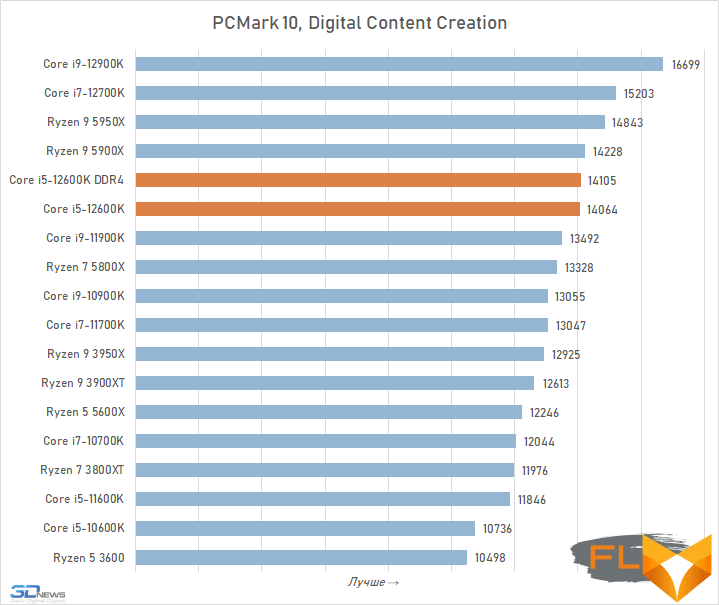
The results of the Core i5-12600K do not differ too much when working with DDR5 and DDR4 memory. Moreover, PCMark 10 does not even allow you to clearly understand which particular type of memory is preferable for Alder Lake – depending on the scenario, one or the other option provides the best performance.
The 3DMark CPU Profile evaluates theoretical gaming performance by simulating the behavior of a large number of AI-controlled in-game objects. This is a new multi-threaded benchmark that makes extensive use of the SSE3 and AVX2 vector instruction sets. To compare processors, we rely on two indicators – maximum performance at full CPU load and performance at eight-thread load, which is typical for most modern DirectX 12 games.
In terms of maximum performance, the Core i5-12600K can be compared with the Core i7-11700K and Ryzen 7 5800X. The new 10-core processor built according to the 6P + 4E scheme is really able to compete with the eight-core processors available on the market and even surpass them. But it still falls short of the flagships Core i9-11900K and Core i9-10900K, at least 3DMark thinks so.

But if you look at the comparison of processors with an eight-thread gaming load, the result of the Core i5-12600K is confidently shifting to the top of the chart. In this case, the 10-core Alder Lake is faster than all the Zen 2, Zen 3, Rocket Lake and Comet Lake processor families without exception. And such a convincing superiority of the Core i5-12600K speaks not only about the progressiveness of the Golden Cove microarchitecture, but at the same time about a good level of performance of the Gracemont cores, since in the case of an eight-thread load, a ten-core processor uses six productive and two energy-efficient cores. However, the Core i7-12700K and Core i9-12900K processors, which have the ability to send all eight threads to the Golden Cove cores, are ahead of the Core i5-12600K by quite noticeable 20-25%.

⇡#Performance in Applications
As has been repeatedly said, Alder Lake is a serious step forward. But the Core i5-12600K exemplifies this claim, perhaps even better than its higher-end brethren. Despite the fact that it belongs to the middle level and costs less than $ 300, its performance in resource-intensive tasks is higher than that of previous generations of Intel flagships. Specifically, in our test suite, the Core i5-12600K outperforms the Core i9-11900K and Core i9-10900K in ten out of twelve tasks. Along the way, it also demonstrates an advantage over the Ryzen 7 5800X: AMD’s eight-core processor outperforms the Core i5-12600K in only one case out of twelve. It turns out that in “heavy” applications, only processors with twelve or sixteen cores can be faster than the ten-core Alder Lake Core i5 series.
However, at the same time, a significant gap remains between the Core i5-12600K and the older Alder Lake. Despite the fact that the Core i5-12600K has almost the same nuclear formula as the Core i7, the lack of two Golden Cove cores in it leads to a lag behind the Core i7-12700K and Core i9-12900K by an average of 21 and 40%, respectively.
As for DDR4 SDRAM, its use “spoils” the performance of the Core i5-12600K not too much. On average, the old memory type causes only a 4 percent performance degradation. True, there are exceptions: the 7-zip archiver works on a system with DDR5 as much as 17% faster, but this example is the only one.
Rendering:
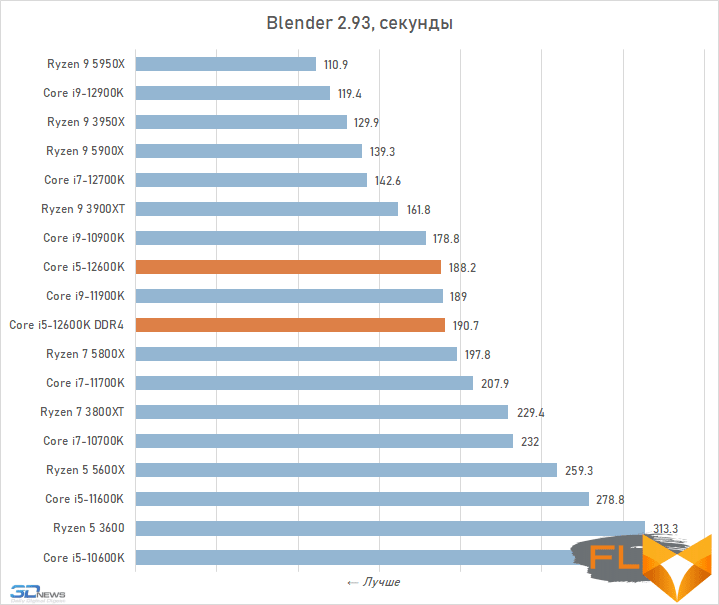
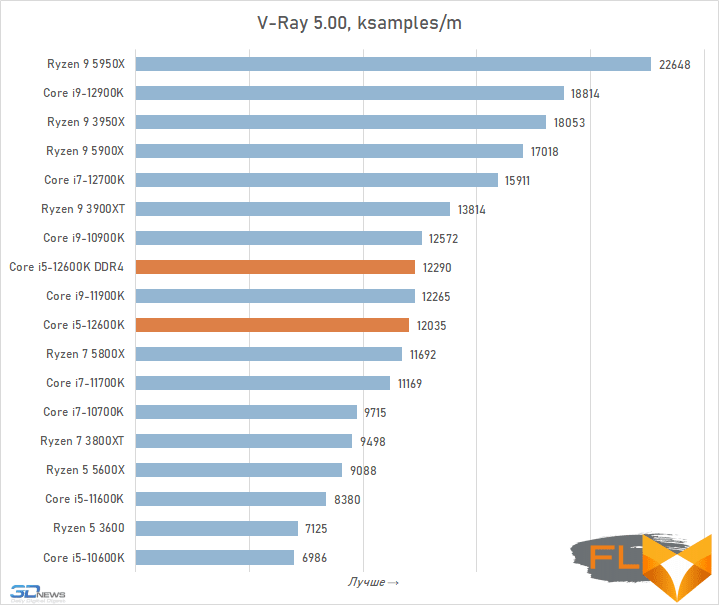
Photo processing:
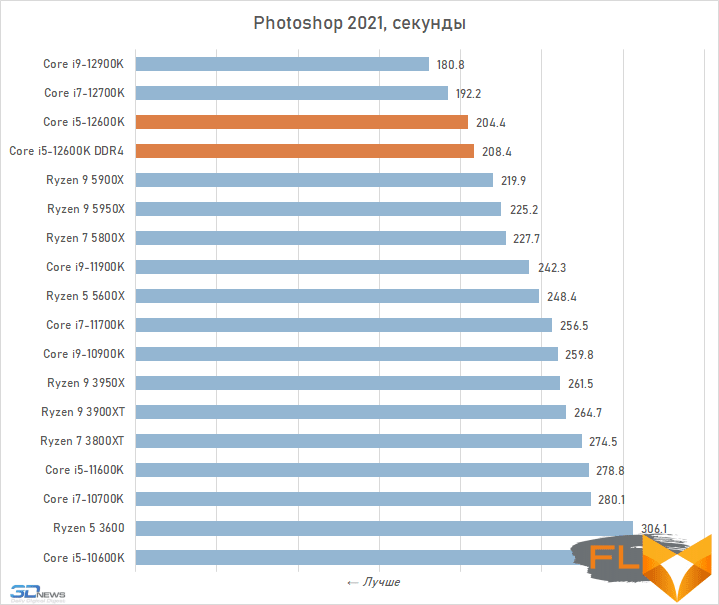
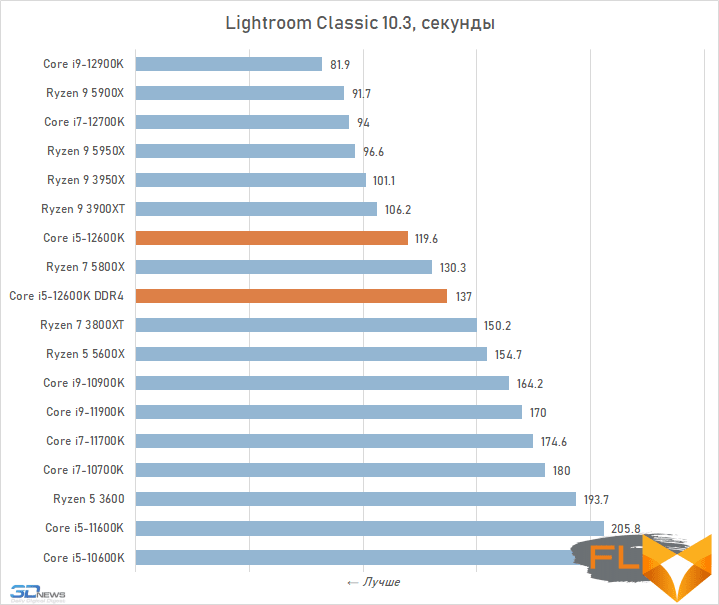
Video work:
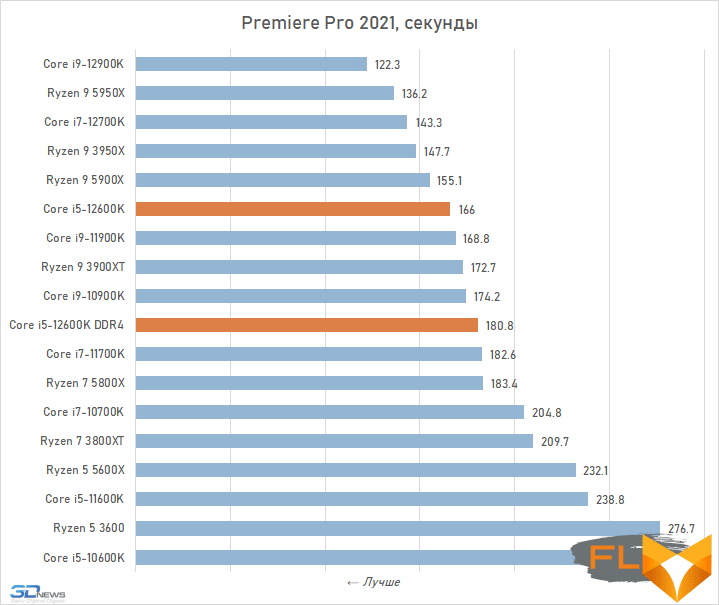
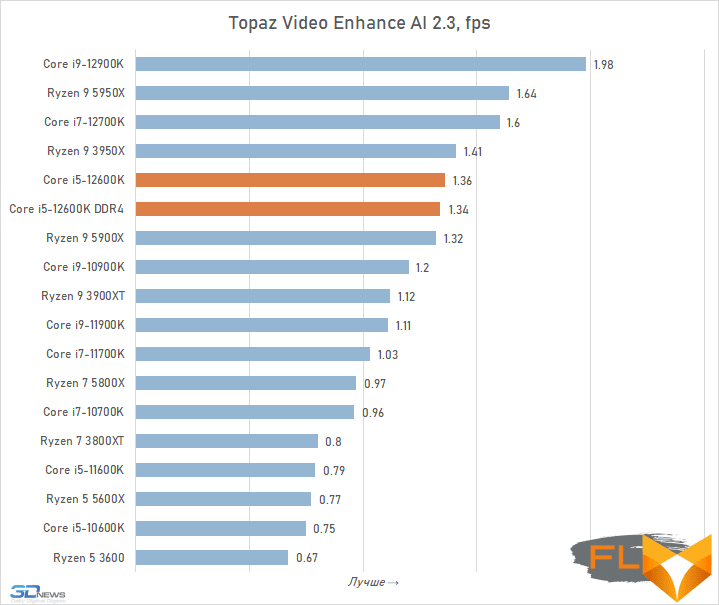
Video transcoding:
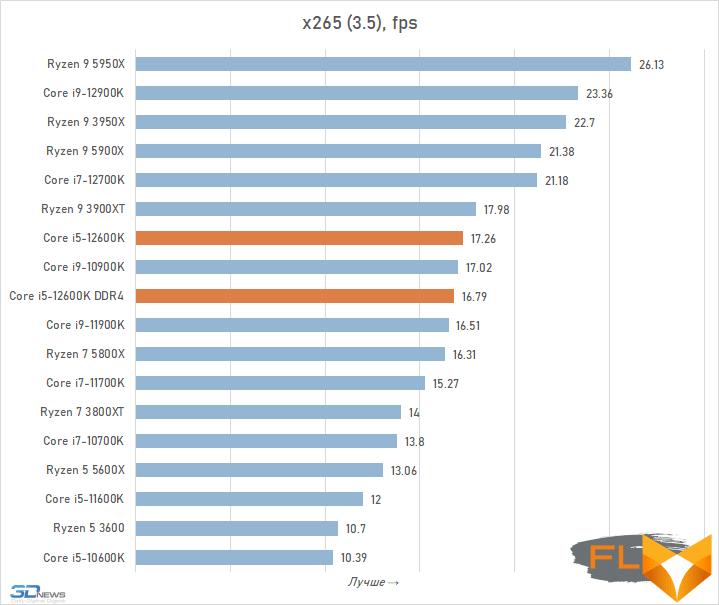

Compilation:
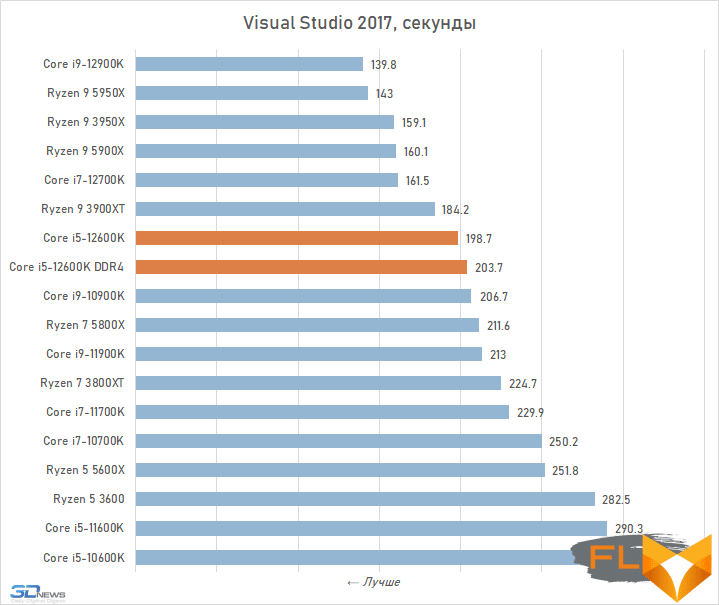
Archiving:

Chess:
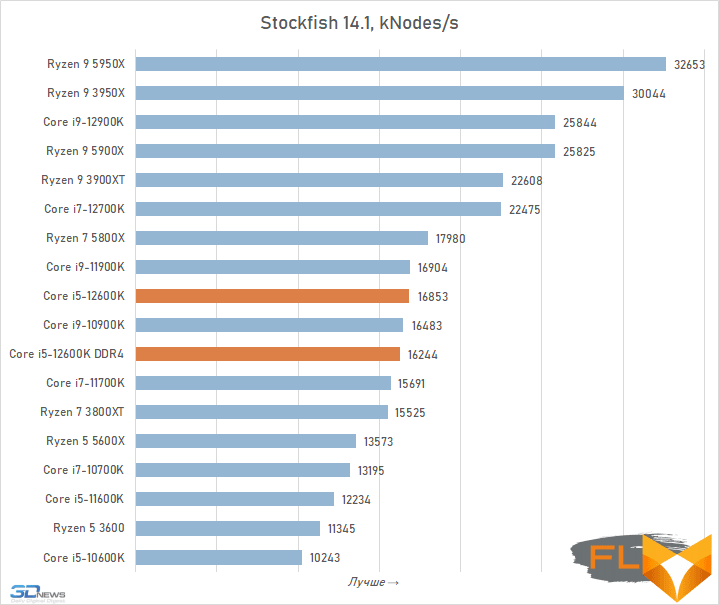
Mathematical calculations:
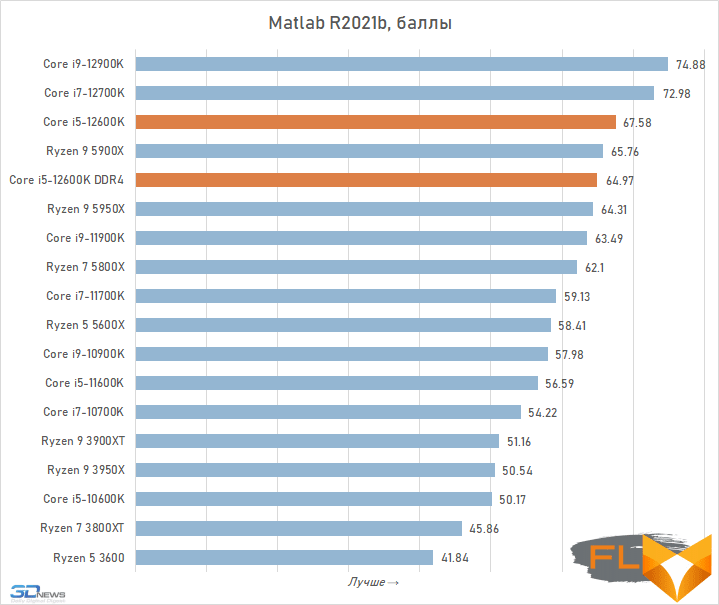
⇡#Game performance
No matter how good the Core i5-12600K looks in resource-intensive applications, its main trump card is gaming performance. The load created by modern games fits perfectly into the 6P + 4E core formula, and the Core i5-12600K is only slightly slower than the flagship Alder Lake. In terms of frame rate in games, it lags behind the older Core i9-12900K by an average of only 6%. And this means that the Core i5-12600K, along with the flagship Alder Lake, has every right to be the best in class gaming processor.
Indeed, in terms of gaming performance, the Core i5-12600K paired with DDR5-6000 is faster than any other processor from the Zen 2, Zen 3, Rocket Lake, and Comet Lake families. In terms of average FPS, the Core i5-12600K in question outperforms the Core i9-11900K by 9%, the Core i9-10900K by 13%, and the Ryzen 9 5950X by 7%. All this is displayed in the diagram below, built according to the results of tests in 12 modern games.
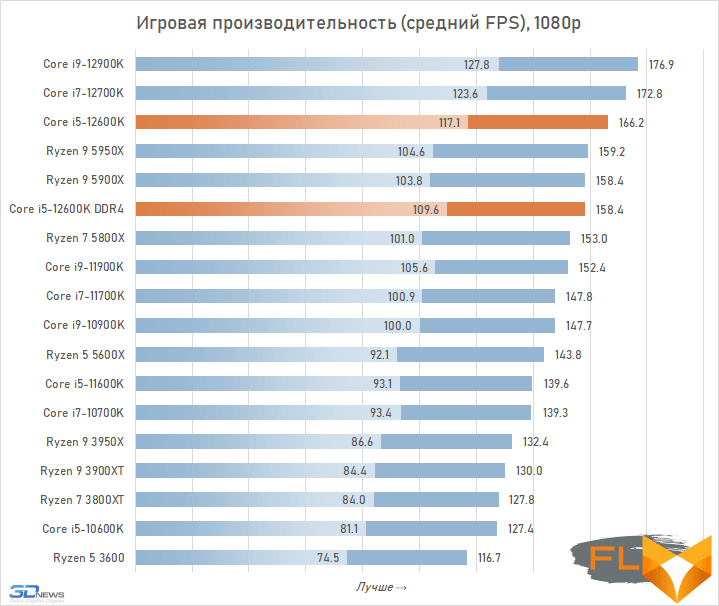
Separately, it is worth noting a rather small difference in the performance of the Core i5-12600K when using DDR5 and DDR4 SDRAM. In other words, memory of an older standard may well be used in LGA1700 gaming systems to optimize their price – there’s nothing to worry about.
However, the load in different games is quite heterogeneous, and sometimes you can see a completely different picture in them. For example, in Chernobylite and Serious Sam: Siberian Mayhem, DDR4 memory allows for higher performance. And games such as Chernobylite and Shadow of the Tomb Raider favor Ryzen processors, and in them the Core i5-12600K loses not only the Ryzen 7 5800X, but even the Ryzen 5 5600X. But at the same time, there was not a single game in our test set where the Core i5-12600K would be inferior to Intel’s flagship processors of previous generations. And this is another example showing how Alder Lake is ahead of its predecessors.
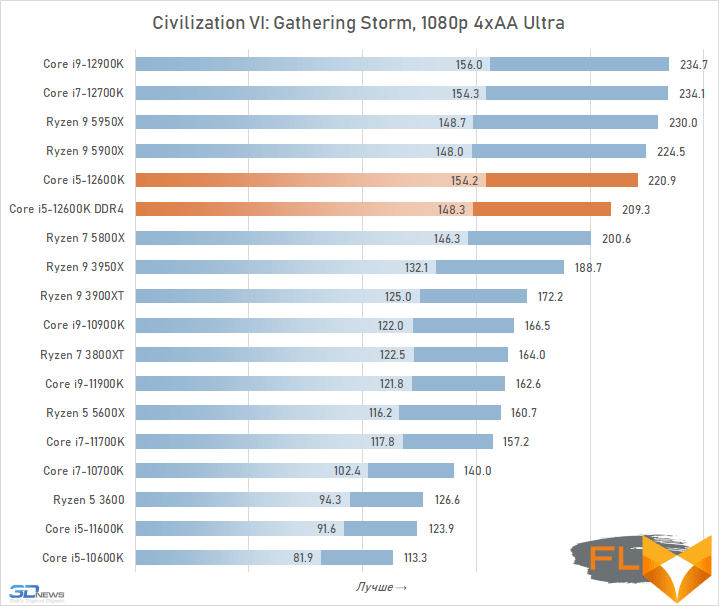
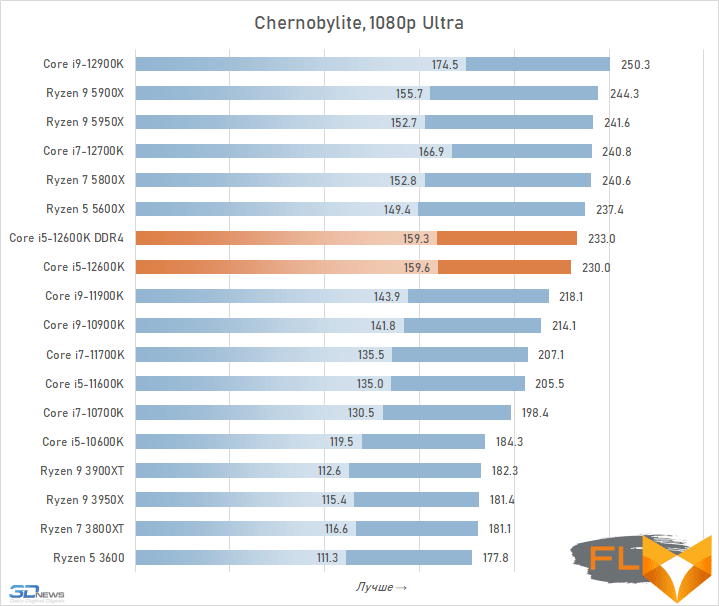
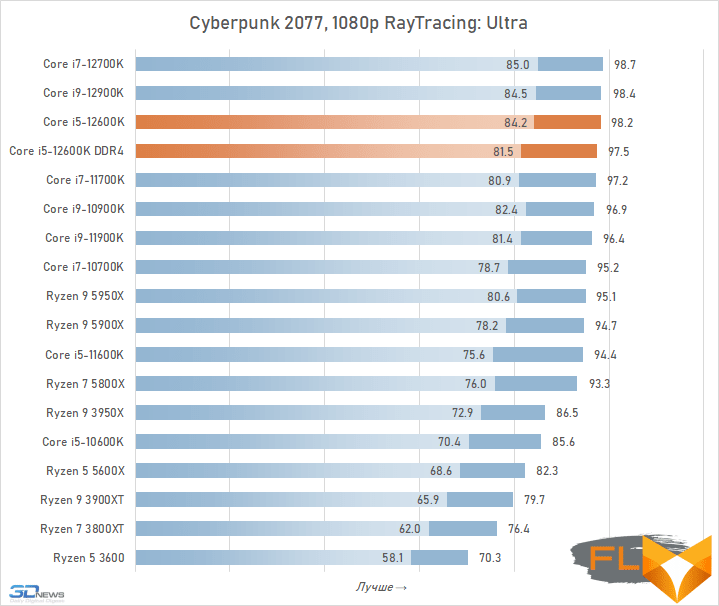

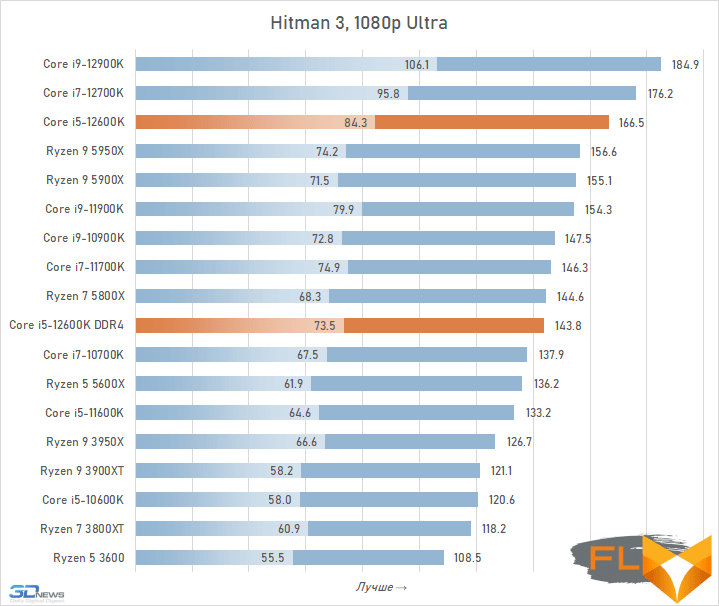
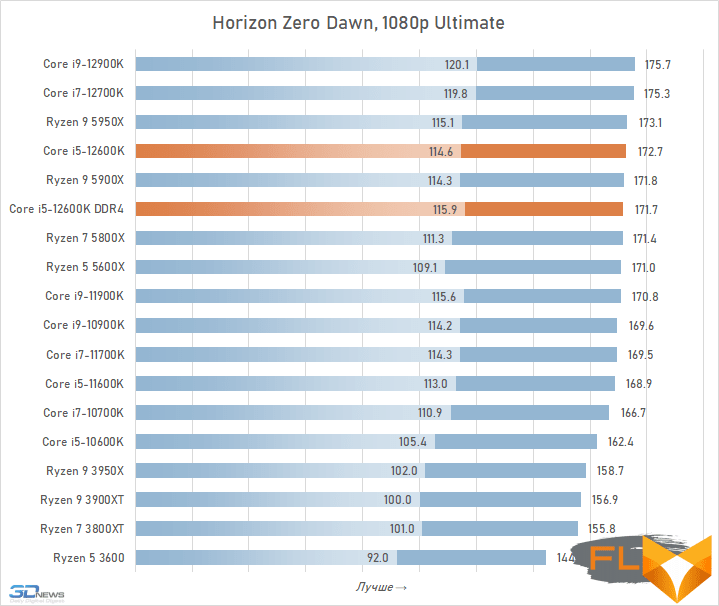
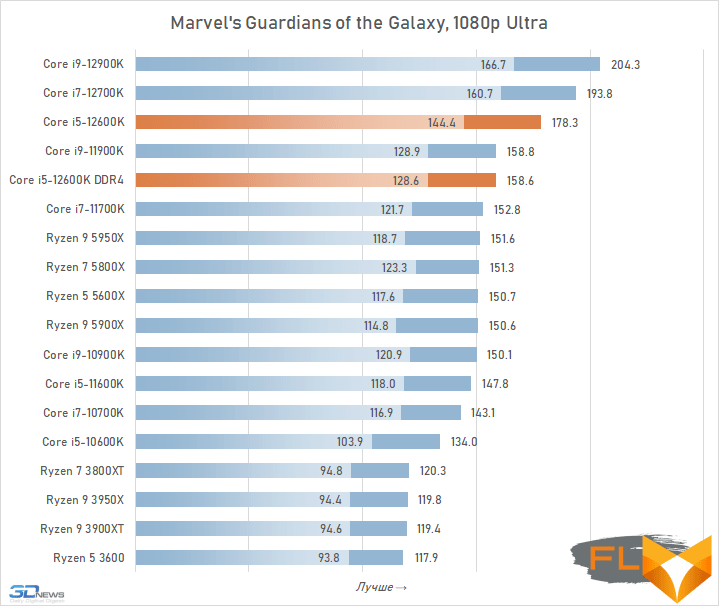


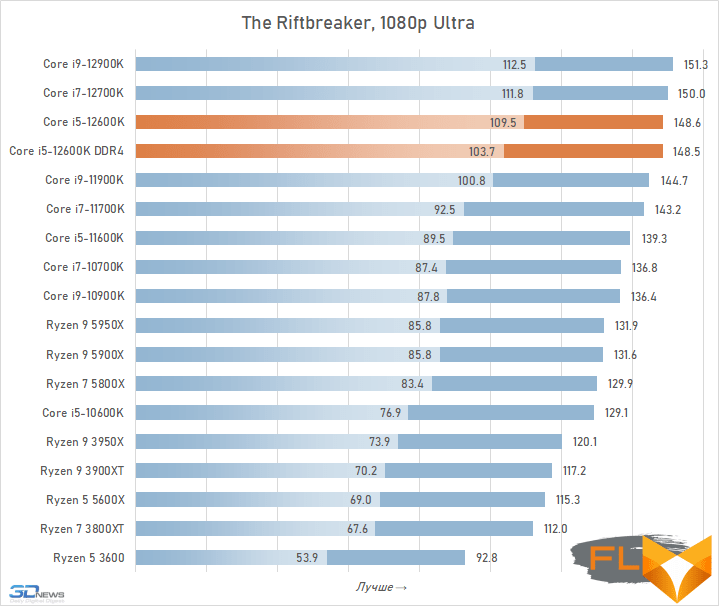
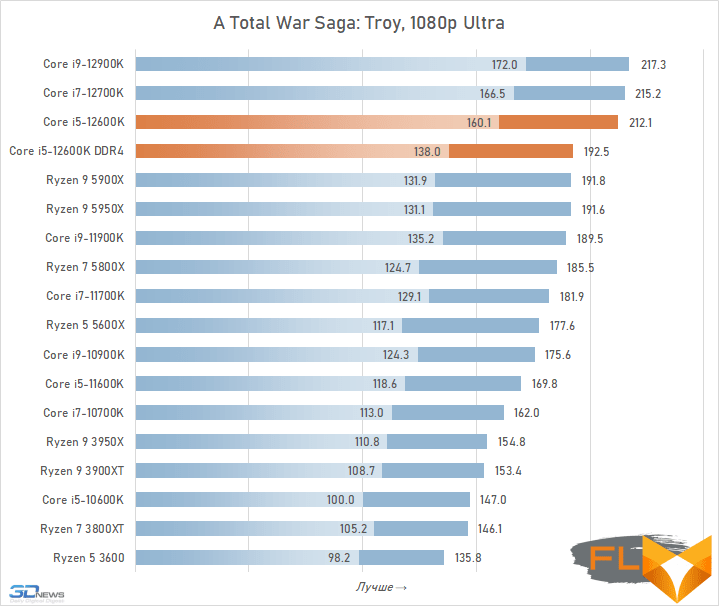
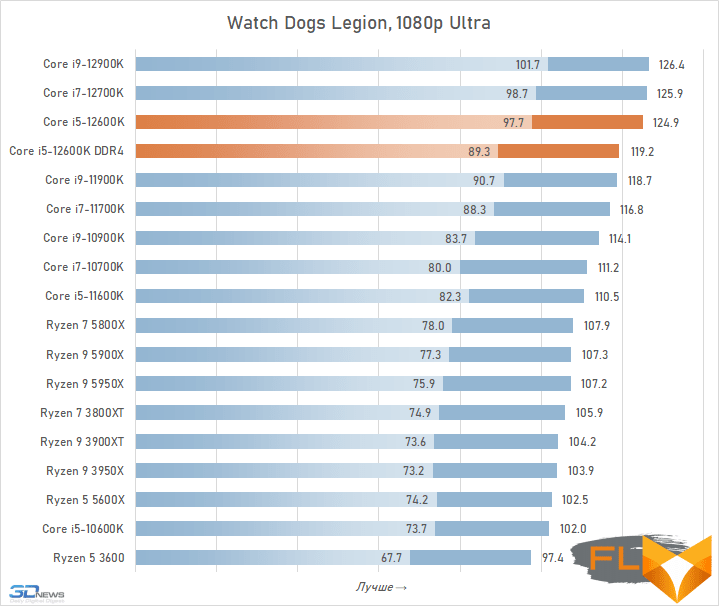
⇡#Conclusions
The Core i5-12600K is an atypical member of the Core i5 series. Unlike other Core i5s – both past and current generations – this processor has not six, but ten computing cores, six of which belong to the productive Golden Cove microarchitecture, and four to the energy-efficient Gracemont. This allows it to run 16 threads simultaneously and makes it a competitor not to the six-core Core i5 and Ryzen 5, but to higher-end processors – the eight-core Core i7 and Ryzen 7. Intel could well have allocated the Core i5-12600K to a separate subgroup of the Core i6 – and it was It would be completely fair, since the rest of the Core i5s, even in the Alder Lake family, do not have such a number of cores and do not have a hybrid architecture.
At the same time, opposing the Core i5-12600K to octa-cores does not put it in a bad light. On the contrary, it’s starting to look like an even more outstanding proposition, as at less than $300 it offers better performance than much more expensive processors from other Intel and AMD processor families.
The facts established in the Core i5-12600K comparative test are as follows: in terms of average performance, it unconditionally outperforms the flagship models of the Comet Lake and Rocket Lake families, and this applies to both games and resource-intensive applications. AMD Ryzen 5000-series processors with six and eight cores also give in to the power of the Core i5-12600K – a representative of the Alder Lake family confidently surpasses them in any workload. At the same time, in applications for creating and processing content, the “semi-professional” Ryzen 9 5900X and 5950X still perform better than the Core i5-12600K due to the larger number of cores. However, this does not apply to games at all: in them, the Core i5-12600K is faster than any modern AMD processor.
At this point, it would be quite possible to stop and declare the Core i5-12600K an ideal option for gaming systems in terms of price and performance, which is also capable of offering a decent level of performance in computing applications. But to keep silent about the fact that, along with excellent performance, this processor also stands out for amazing energy efficiency, it would be dishonest.
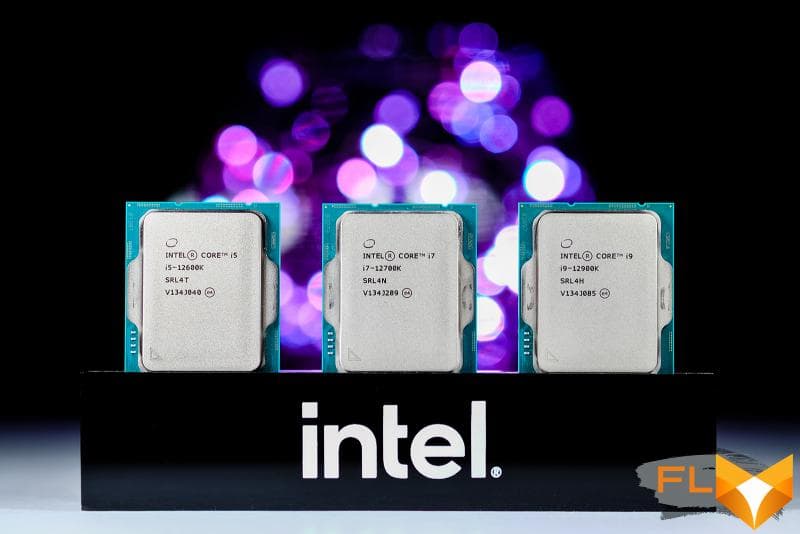
The fact is that the Core i5-12600K is fundamentally different from the older brothers of the Alder Lake family and has rather modest energy appetites. The maximum power consumption level recorded during testing in real applications was only 120 W – this is not only lower than the consumption of previous generations of similar Intel processors, but also less than AMD processors with a thermal package of 95 W actually require for their operation. Thus, the Core i5-12600K can be awarded the championship title not only in terms of specific performance per dollar, but also in terms of specific performance per watt. Moreover, in the second case, its advantage over alternatives will be no less impressive.
From a practical point of view, this means that the Core i5-12600K does not need bulky cooling systems and motherboards with monstrous power schemes at all. Relatively inexpensive components that would never have occurred to anyone before combined with processors of this class are also quite suitable. And by the way, you can save money when assembling a system based on the Core i5-12600K at the stage of choosing memory. Tests have shown that this processor outperforms DDR4 SDRAM very well – yes, the performance is slightly lower than when using DDR5 memory, but the difference is a few percent, so the savings can be fully justified.
Ultimately, it remains to be recognized that Intel managed to create a truly unique processor that currently does not have worthy alternatives in its price segment. Choosing something other than the Core i5-12600K for mid-range configurations, especially when it comes to gaming builds, is simply unreasonable – any other option will be significantly worse both in terms of performance and power consumption. Therefore, the Core i5-12600K receives a well-deserved Best Buy award from us, and in subsequent reviews we will try to check whether the laurels of the older Core i5 extend to the younger processors of the series, primarily the Core i5-12400.




